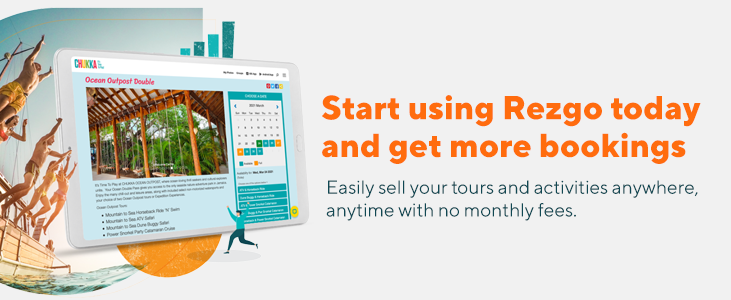
I often get asked how online activity marketplaces actually work, how providers get paid, and what the sales process is like. To make things a little simpler for tour and activity operators who are interested in reselling their tours through online marketplaces like Viator, GetYourGuide, Orbitz, Expedia, and the others, I thought I would create an infographic that helps to explain the process better.
First of all, I think it is really important to mention that working with most marketplaces is a very manual process. Although many of them have their own extranets (or systems for loading products), the process of managing inventory is rudimentary and there is no live availability checking. Your tours will either be sold on a free sale basis (meaning there are no limits to the number of bookings that they can make) or they will be on a request basis (meaning that every booking must be confirmed by you before the customer gets a confirmation).
The process of working with these marketplaces is fairly similar. Here are the basics parts of the process:
1. Contracting with the marketplace – In some cases this process requires you to contact the marketplace via email or through an online form. In other cases, the marketplace may require you to sign-up online through their website. In this case, you may be bound to a specific commission rate with the marketplace.
2. Submitting your products – Once your contract is in place, you submit your products via email (as a spreadsheet) or you might upload your product descriptions and photos through a provider administrative website. For marketplaces where the products are curated (like Viator), the marketplace will most likely manage this process themselves.
3. Reseller approves your products – Often the reseller will review your products to make sure they are not duplicates of another tour or to make sure that the content is unique. This is because the reseller wants to avoid duplicate content issues in Google.
4. Your tours are displayed on the marketplace – Once the products are approved, they will appear in the reseller’s marketplace. Quite often these marketplaces resell hundreds or even thousands of tours from hundreds of providers. Usually your tours will appear alongside other competing tours for your destination.
5. Customer books your tours – Customers browsing the marketplace may choose to book your tour. If they choose your tour, they will pay the marketplace the retail cost for the tour. Usually when you contract with the marketplace, you provide your tour at a discount (between 15-30%). The margin is what the marketplace earns as their revenue. The marketplace collects the payment for the customer and holds the money.
6. Customer receives a voucher – If the tour being booked is a free sell product, the customer receives a voucher right away. This may be emailed directly to the customer or downloaded from the marketplace. At the same time, you will receive an email from the marketplace confirming that you have received a new booking. If the tour is “on request”, then you will receive an email asking you to confirm the booking within 24 hours. If you confirm the booking, the customer receives a confirmation and voucher. If you do not confirm the booking, the customer receives a notification that the booking is cancelled.
7. Customer goes on your tour – On the pre-scheduled date the customer will show up to take your tour. They will present the marketplace voucher to you as proof of purchase. You collect the vouchers from the customers for later redemption.
8. Return the vouchers to the reseller – In some cases you may be required to return the vouchers by mail to the reseller along with an invoice for services rendered. Once received, the reseller reviews the vouchers for accuracy.
9. You get paid – After the vouchers have been reviewed, the reseller sends a check or an electronic funds transfer to your bank account. Some marketplaces pay out their providers as soon as 24 hours after a tour has been taken while others may take as long as 30 days to pay for tours that have been taken.





